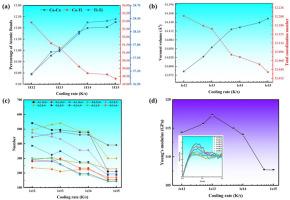基于分子动力学模拟的Co40Ti60非晶合金原子键比及微观组织演变定量研究
IF 4.7
3区 材料科学
Q2 MATERIALS SCIENCE, MULTIDISCIPLINARY
引用次数: 0
摘要
本研究采用分子动力学模拟方法,系统研究了冷却速率对Co40Ti60非晶合金组织演变和结合特性的影响。基于对分布函数、配位数、原子键比、Voronoi体积和相关多面体特征进行了综合分析,阐明了在一系列冷却条件下异核和同核键的演化。结果表明,随着冷却速率的增加,Co-Ti异核键的比例逐渐降低,Co-Co和Ti-Ti同核键的比例相应增加。这一趋势表明,快速冷却抑制了有序结构的形成,导致相邻原子之间的键类型分布更加随机。与此同时,总体配位数减少,平均Voronoi体积增加,表明局部结构向更加开放和无序的方向转变。相比之下,在较低的冷却速率下,原子有更多的时间进行重排,导致形成更多的异核键和特征有序簇,从而增强结构致密性和短程有序性。总体而言,随着冷却速率的增加,杨氏模量呈下降趋势,在1e13 K/s时达到最大值。这种异常是由于在这种特定冷却条件下形成的有序簇的峰值数量引起的局部优化结构协同作用。本文章由计算机程序翻译,如有差异,请以英文原文为准。

Quantitative study on atomic bond proportions and microstructural evolution in Co40Ti60 amorphous alloys via molecular dynamics simulation
This study employed molecular dynamics simulations to systematically investigate the influence of cooling rate on the microstructural evolution and bonding characteristics of Co40Ti60 amorphous alloys. A comprehensive analysis based on pair distribution functions, coordination numbers, atomic bond proportions, Voronoi volume and associated polyhedral features was conducted to elucidate the evolution of heteronuclear and homonuclear bonds under a range of cooling conditions. The results revealed that as the cooling rate increased, the proportion of Co–Ti heteronuclear bonds gradually decreased, whereas the proportions of Co–Co and Ti–Ti homonuclear bonds increased correspondingly. This trend suggests that rapid cooling suppresses the formation of ordered structures, resulting in a more random distribution of bonding types among neighboring atoms. Meanwhile, the overall coordination number decreased, and the average Voronoi volume increased, indicating a transition toward a more open and disordered local structure. In contrast, at lower cooling rates, atoms have more time for rearrangement, leading to the formation of more heteronuclear bonds and characteristic ordered clusters, thereby enhancing structural compactness and short-range order. Overall, the Young's modulus exhibited a decreasing trend with increasing cooling rate, reaching a maximum at 1e13 K/s. This anomaly is attributed to the locally optimized structural synergy induced by a peak number of ordered clusters formed under this specific cooling condition.
求助全文
通过发布文献求助,成功后即可免费获取论文全文。
去求助
来源期刊

Materials Chemistry and Physics
工程技术-材料科学:综合
CiteScore
8.70
自引率
4.30%
发文量
1515
审稿时长
69 days
期刊介绍:
Materials Chemistry and Physics is devoted to short communications, full-length research papers and feature articles on interrelationships among structure, properties, processing and performance of materials. The Editors welcome manuscripts on thin films, surface and interface science, materials degradation and reliability, metallurgy, semiconductors and optoelectronic materials, fine ceramics, magnetics, superconductors, specialty polymers, nano-materials and composite materials.
 求助内容:
求助内容: 应助结果提醒方式:
应助结果提醒方式:


